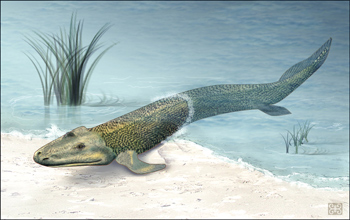
A single fish species made its way to land around 365 million years ago.
These were the earliest tetrapods. These organisms created a branch of life that would eventually give rise to innumerable species, including birds, reptiles, and amphibians. We are all descended from these first tetrapods, therefore we share their history of moving from the ocean to the land.
What if they turned around and stayed put instead of heading to the beaches? Just as they were about to exit the sea, what if these creatures had returned to more open water?
A recent fossil shows that only one fish may have accomplished this. The newly discovered creature has fins made for swimming, in contrast to other closely related animals that used them to maintain their bodies on the bottom of the water and perhaps occasionally go out onto land.
In March 2020, THOMAS STEWART was working in Neil Shubin’s lab at Chicago University. he worked with another researcher in his group, Justin Lemberg. They were preparing a fossil that they had discovered during an adventure to Canada’s Arctic in 2004.
Pieces of the jaws, which were around 5 cm long and had angular teeth, could be seen sticking out of the rock where it was buried. There were also areas covered in white scales with a rough appearance. From the anatomy, they could tell that the fossil belonged to an early tetrapod. they desired to examine the rock’s interior. To locate any hidden objects, they used CT scanning equipment, which emits X-rays through the specimen and scanned a piece of unassuming rock with a few scales and found a complete fin inside.
The fin was revealed
This fin is very precious. This fin can provide scientists with clues about how early tetrapods evolved and how they lived hundreds of millions of years ago and it can predict whether an animal is walking or swimming based on certain bones in the skull.
The first scan of the fin looked promising but still needed to see the skeleton in higher resolution. Once Thomas returned to campus, a professor from the university’s geophysical sciences department helped them trim the block with a rock saw. This allowed for better scanning and closer inspection of the fin.
The creature was a new species, they discovered it when the dust had settled and they had examined data on the fin, jaws, and scales. The limbed vertebrates—animals with fingers and toes—are this creature’s close relatives.
The ecosystem in which this fish existed hundreds of millions of years ago was as follows. Rivers and streams were present. David Wake, a researcher who inspired many of us in evolutionary and developmental biology, is honored by the species name of this animal.
Skeletons show how an animal lived
Qikiqtania tells us a lot about the history of our lineage. Researchers can see through its scales that the animal was underwater. These sensory canals would have enabled the animal to sense the water flowing around it.
Its jaws indicate that it was hunting as a predator. It is Qikiqtania’s pectoral fin, however, that is the most remarkable. It also has a humerus bone like our upper arm. Qikiqtania’s is a unique shape.
A primitive tetrapod with humeri that have a pronounced ridge at the bottom and a group of bumps wherein muscles attach, Tiktaalik has these characteristics. These bony outgrowths reveal that earlier tetrapods used their arms or fins to support themselves on land and underwater as they lived on the bottom of streams and lakes.
The humerus is distinct in Qikiqtania. The humerus of Qikiqtania lacks the ridges and processes that make it distinctive. This fin’s humerus, on the other hand, is tiny and boomerang-shaped. However, the majority of the fin is sizable and paddle-shaped. This fin was made with swimming in mind. Qikiqtania was carrying out an entirely different activity than other early tetrapods, which were gaining knowledge from the land. Its humerus is absolutely unusual, unlike any other known example.
Evolution doesn’t mean a march in the same direction
The process of evolution is not linear. Although it could seem that the earliest tetrapods were progressing directly toward land-based life, Qikiqtania exposes the shortcomings of this directional view.
Humanity did not ascend through evolution. The complicated tree of life is made up of a myriad of interconnected activities. They evolve into new species as they diversify. The branch has a lot of potential directions.
This fossil is special for a variety of reasons. The fact that this fish was kept in rocks for hundreds of millions of years before being found by scientists on Ellesmere Island in the Arctic is astonishing in and of itself. The fact that its entire anatomy was accidentally discovered just as a pandemic was about to spread worldwide makes it even more astounding.
Additionally, it provides a glimpse into the larger diversity and range of fish life habits when they transfer from the water to the land. The intriguing and complicated tree can be understood by researchers by looking beyond a ladder.





